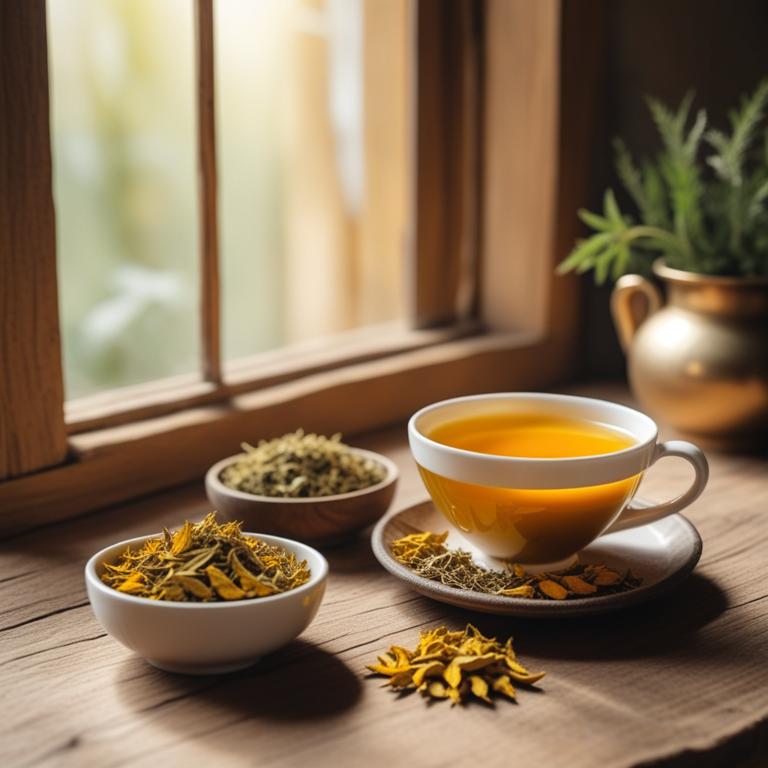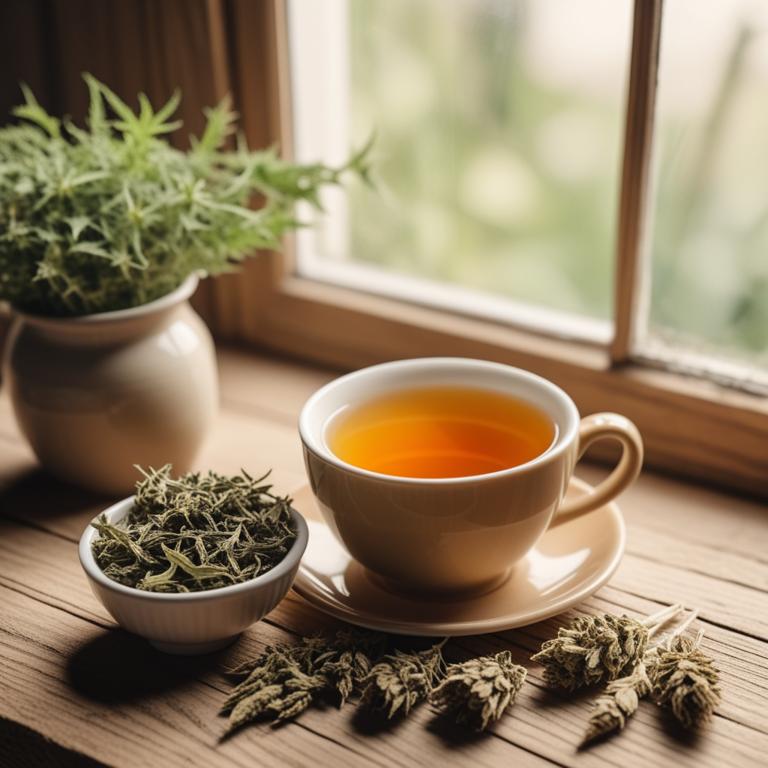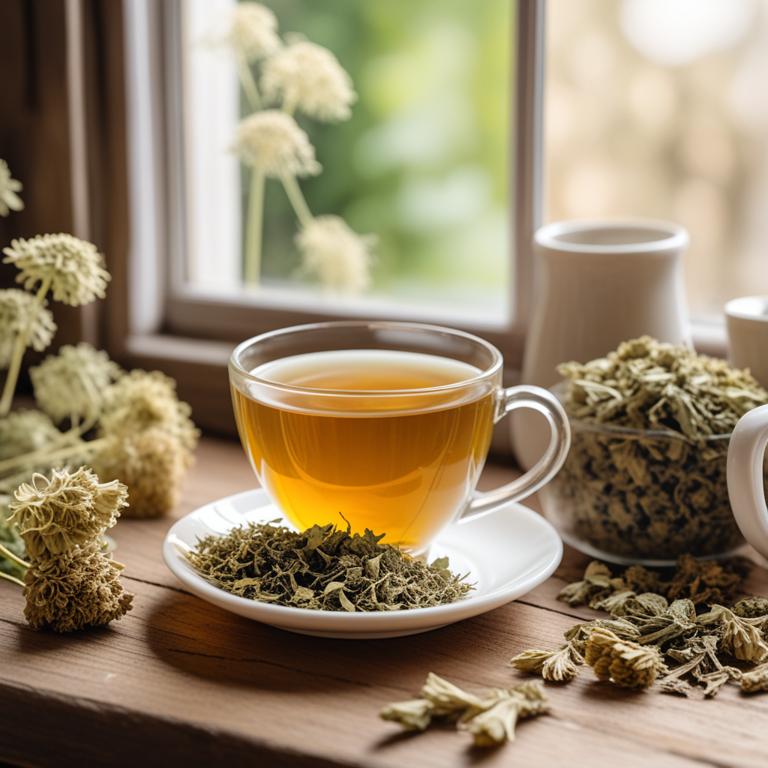8 Herbal Teas For Endometriosis

Herbal teas can be a great way to help manage endometriosis symptoms.
Endometriosis is a condition where tissue similar to the lining of the uterus grows outside of it, causing pain, inflammation, and other issues. Herbal teas, like those made from Curcuma longa (turmeric), Zingiber officinale (ginger), and Glycyrrhiza glabra (licorice root), contain compounds that have anti-inflammatory and antioxidant properties. These properties can help reduce inflammation and pain associated with endometriosis. The curcumin in turmeric, for example, has been shown to inhibit the growth of endometrial tissue and reduce inflammation. Ginger, on the other hand, has anti-inflammatory compounds like gingerol and shogaol that can help alleviate pain and discomfort.
Licorice root, rich in glycyrrhizin, can help soothe the digestive system and reduce inflammation in the abdominal area. Drinking these herbal teas may also help regulate menstrual cycles and reduce the severity of symptoms. Many women with endometriosis find that drinking herbal teas regularly helps them feel more comfortable and in control of their bodies. Additionally, these teas are often easy to make at home and can be a calming and comforting part of a daily routine. Some people find that drinking herbal teas helps them relax and reduce stress, which can also be beneficial for managing endometriosis symptoms. It's essential to note that while herbal teas may provide relief for some women with endometriosis, they should not be used as a replacement for medical treatment.
It's always best to consult with a healthcare provider before trying any new remedies, especially if you're already taking medication or have a severe case of endometriosis.
- 1. Curcuma longa
- 2. Zingiber officinale
- 3. Glycyrrhiza glabra
- 4. Ginkgo biloba
- 5. Urtica dioica
- 6. Angelica archangelica
- 7. Lavandula angustifolia
- 8. Paeonia lactiflora
1. Curcuma longa

Curcuma longa teas contains bioactive constituents like curcumin, demethoxycurcumin, and bisdemethoxycurcumin.
These compounds have potent anti-inflammatory and antioxidant properties that help reduce inflammation in the body. Inflammation is a key factor in endometriosis, a condition where tissue similar to the lining of the uterus grows outside the uterus, leading to pain and discomfort. The anti-inflammatory properties of curcuma longa tea help reduce inflammation in the endometrial implants, which can help alleviate pain and other symptoms associated with endometriosis.
Additionally, curcuma longa tea's antioxidant properties help protect the body from oxidative stress, which can contribute to the development and progression of endometriosis.
- Gather 1 cup of water and 1 tablespoon of dried Curcuma longa root.
- Heat the water in a saucepan over medium heat until it starts boiling.
- Reduce heat to low and add the dried Curcuma longa root. Let it simmer for 5-7 minutes.
- Strain the mixture into a cup using a fine-mesh sieve or cheesecloth. Discard the solids.
- Drink the tea immediately, 2-3 times a day, as needed.
2. Zingiber officinale

Zingiber officinale teas contains a compound called gingerol, which has anti-inflammatory properties that help reduce pain and swelling associated with endometriosis.
Gingerols also have antiproliferative effects, meaning they can slow down the growth of endometrial tissue, a common issue in endometriosis. The bioactive constituents in Zingiber officinale, including gingerols and shogaols, have been shown to inhibit the production of prostaglandins, hormone-like substances that contribute to pain and inflammation in endometriosis. The warming properties of ginger can also help relax the uterine muscles and improve blood flow, which can help alleviate symptoms of endometriosis.
By reducing inflammation and pain, Zingiber officinale teas may provide relief for women suffering from endometriosis.
- Gather 1 cup of fresh ginger root and 2 cups of water.
- Peel the ginger root and slice it thinly to make 2-3 tablespoons.
- Boil the water in a pot and add the sliced ginger.
- Reduce heat and let it simmer for 5-7 minutes.
- Strain the tea and drink 1/2 cup, 2-3 times a day, for relief from endometriosis symptoms.
Zingiber Officinale Tea on Amazon
FGO Organic Ginger Tea, 100 Count, Eco-Conscious Tea Bags, Caffeine Free, Packaging May Vary (Pack of 1)
Disclaimer: We earn a commission if you click this link and make a purchase at no additional cost to you.
3. Glycyrrhiza glabra

Glycyrrhiza glabra teas contains glycyrrhizin, a key active constituent that helps reduce inflammation and alleviate symptoms of endometriosis.
The anti-inflammatory properties of glycyrrhizin soothe the lining of the uterus, reducing pain and discomfort associated with endometriosis. Glycyrrhiza glabra also contains flavonoids and saponins, which have been shown to have antioxidant and estrogen-regulating effects, helping to balance hormone levels and reduce endometrial growth. The anti-estrogenic properties of glycyrrhizin may also help slow down endometriosis progression by reducing the growth of endometrial tissue.
Regular consumption of Glycyrrhiza glabra teas may provide relief from endometriosis symptoms by addressing inflammation, hormonal imbalances, and tissue growth.
- Gather 1 cup of Glycyrrhiza glabra roots and 4 cups of water.
- Clean the roots and chop them into small pieces.
- Boil the 4 cups of water in a pot.
- Add the chopped roots to the boiling water and let it simmer for 10-15 minutes.
- Strain the tea and drink 1-2 cups per day as needed.
4. Ginkgo biloba

Ginkgo biloba teas contains flavoglycosides, bilobalide, and ginkgolides, which are active constituents that have anti-inflammatory and antioxidant properties.
These properties help to reduce inflammation and oxidative stress in the body, which are common issues associated with endometriosis. Flavoglycosides and bilobalide can help to improve blood flow and reduce vascular constriction, which may alleviate symptoms such as pelvic pain and heavy menstrual bleeding. Ginkgolides have been shown to have a potential anti-endometriotic effect by inhibiting the growth of endometrial cells and reducing the production of pro-inflammatory cytokines.
By consuming Ginkgo biloba teas, some individuals may experience a reduction in endometriosis symptoms and an improvement in their overall quality of life.
- Gather 1 cup of boiling water and 1 teaspoon of dried Ginkgo biloba leaves.
- Steep the Ginkgo biloba leaves in the boiling water for 5-7 minutes.
- Strain the tea into a cup using a tea strainer or a piece of cheesecloth.
- Add honey or lemon to taste, if desired. Stir well.
- Drink the tea 2-3 times a day, ideally on an empty stomach, to help alleviate endometriosis symptoms.
5. Urtica dioica

Urtica dioica teas contains bioactive constituents like iridoid glycosides and saponins, which are known for their anti-inflammatory properties.
These compounds help to reduce inflammation in the body, which is a key factor in endometriosis. The antioxidants in Urtica dioica, such as quercetin and kaempferol, also have a soothing effect on the body and can help to calm inflammation in the endometrial tissue. Additionally, the tea has been found to have a regulating effect on the immune system, which can help to reduce the body's inflammatory response to endometrial growths.
By reducing inflammation and regulating the immune system, Urtica dioica teas may help to alleviate symptoms associated with endometriosis.
- Gather 1 cup of fresh Urtica dioica leaves, 1 cup of boiling water, and a tea strainer.
- Wash the Urtica dioica leaves with cold water to remove dirt and impurities.
- Steep the leaves in boiling water for 5-7 minutes, then strain the liquid using a tea strainer.
- Add 1 tablespoon of honey to the tea, if desired, and mix well.
- Drink 1-2 cups of the tea per day, ideally before meals, to help alleviate endometriosis symptoms.
6. Angelica archangelica

Angelica archangelica teas contains a number of bioactive constituents, including ferulic acid, caffeic acid, and umbelliferone.
These compounds have anti-inflammatory properties, which can help to reduce the inflammation and pain associated with endometriosis. The teas also contain antioxidants, such as flavonoids and phenolic acids, that can help to protect the body from oxidative stress and promote healing. Additionally, Angelica archangelica teas have been found to have estrogen-modulating properties, which can help to balance hormone levels and alleviate symptoms of endometriosis.
By reducing inflammation, promoting healing, and regulating hormone levels, Angelica archangelica teas may offer relief from some of the symptoms of endometriosis.
- Gather 1 cup of fresh Angelica archangelica root or 2 tablespoons of dried root.
- Crush the root into small pieces if using fresh, or use dried root as is.
- Measure 1 cup of water in a pot and bring it to a boil.
- Add the crushed or dried Angelica archangelica root to the boiling water and reduce heat to a simmer.
- Steep for 5-7 minutes, then strain the tea and discard the root. Drink 1-2 cups of tea per day.
7. Lavandula angustifolia

Lavandula angustifolia teas contains flavonoids, such as apigenin and luteolin, which have anti-inflammatory properties.
These properties can help reduce inflammation and pain associated with endometriosis. Lavandula angustifolia also contains terpenes, including camphor and borneol, which have a relaxing effect and can help reduce stress and anxiety. The tea's antioxidant properties, due to the presence of flavonoids and terpenes, can also help protect the body from oxidative stress.
By reducing inflammation, stress, and oxidative stress, Lavandula angustifolia teas may help alleviate symptoms of endometriosis.
- Gather 1 cup of dried Lavandula angustifolia flowers and a tea infuser.
- Measure 1 tablespoon of dried flowers and put them in the tea infuser.
- Heat 1 cup of water in a pot until it reaches 212°F (100°C).
- Steep the tea infuser with the Lavandula angustifolia flowers in the hot water for 5-7 minutes.
- Strain the tea and drink 1-2 cups throughout the day, ideally before bed.
8. Paeonia lactiflora

Paeonia lactiflora teas contains paeniflorin, paeoniflorin, and paeonol as its active constituents.
These compounds have anti-inflammatory and antispasmodic properties, which can help alleviate the pain and inflammation associated with endometriosis. Paeonol, in particular, has been shown to reduce prostaglandin levels, which are involved in the production of endometrial tissue growth. The anti-inflammatory effects of paeniflorin and paeoniflorin may also help reduce scarring and adhesion formation in the pelvic area.
By reducing inflammation and prostaglandin levels, Paeonia lactiflora teas may provide relief from endometriosis symptoms.
- Gather 2 tablespoons of dried Paeonia lactiflora root and 1 cup of boiling water.
- Steep the dried root in boiling water for 5-7 minutes.
- Strain the mixture and discard the root.
- Drink 1/2 cup of the tea 2-3 times a day, preferably after meals.
- Consult a healthcare professional before using Paeonia lactiflora tea for endometriosis treatment or management.